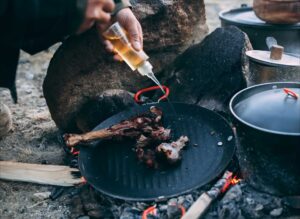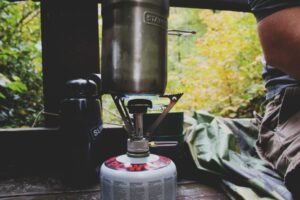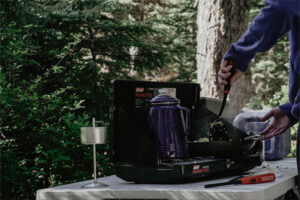
Hiking in the winter can be enjoyable and much less scary if you have the proper equipment, dress in layers of appropriate winter hiking clothing, and take careful precautions when making travel plans.
When it is cold outside, staying dry is your main concern. Hypothermia can result from both cold and wet weather. Even in mild cases, the combination of dampness and coldness is unbearable. By using these helpful winter hiking tips, which include how to stay warm and what gear is needed for winter hiking, you can avoid it.
Factors to Consider
Weather Conditions
- Expect significant swings in temperature throughout the day, especially at higher altitudes.
- Pack for the coldest anticipated temperature, not just the average.
- Consider the type and amount of potential precipitation (snow, rain, sleet).
- Choose waterproof breathable layers and outerwear suitable for the wetness.
- Wind chill can dramatically decrease your body temperature. Pack windproof layers and a sturdy shelter that can withstand gusts.
- Steeper and icy slopes might require crampons or traction devices. Snow depth affects boots and gaiter choices.
- Day hikes require less gear than multi-day trips. Consider food, water, and sleep systems for overnight outings.
Packing Tips
Organize your gear. Separate layers, food, and emergency supplies into easily accessible compartments.
Use waterproof compression sacks. Protect electronics and clothing from potential moisture.
Pack layers easily. Choose clothing that can be layered or shed quickly to adjust to changing temperatures.
Distribute weight evenly. Balance your backpack’s weight to avoid fatigue and discomfort.
Winter Hiking Skills
Learn about layering. Understand how to layer properly for optimal warmth and moisture management.
Practice winter navigation. Master map and compass skills and learn to use a GPS device if applicable.
Know avalanche safety. If venturing into avalanche terrain, take an avalanche safety course and carry appropriate equipment.
Plan for emergencies. Understand snow-specific first aid techniques and emergency signaling methods.
Keep in Mind
Research your route. Get in-depth information about the trail conditions, expected weather, and potential hazards.
Check regulations. Be aware of the local regulations and permits required for winter hiking in specific areas.
Leave no trace. Respect the environment and pack out all your trash, avoiding any damage to the natural landscape.
20 Winter Hiking Essentials
Insulated Waterproof Boots
Boots that are waterproof and insulated will keep your feet dry and warm. Look for those with good traction in slippery conditions.
Insulating Socks
Wear moisture-wicking and insulating socks to prevent frostbite and keep your feet comfortable.
Insulating Layers
Wear multiple layers to retain heat. An insulating layer is added after the moisture-wicking base layer, and a waterproof outer layer is the last layer.
Waterproof Outer Layer
A waterproof jacket and pants protect you from rain and snow, keeping you dry and warm.
Gloves or Mittens
Insulated, waterproof gloves or mittens are essential to protect your hands from cold and wet conditions.
Hat
A thermal hat retains heat and shields your head and ears from the cold wind.
Gaiters
Gaiters cover your boots and lower legs, preventing snow from entering and keeping your legs dry.
Snowshoes or Crampons
Use snowshoes for deep snow and crampons for icy conditions to improve traction.
Trekking Poles
Provide stability, distribute weight, and offer support on slippery surfaces.
Winter Backpack
Carry a backpack with enough space for extra layers, food, water, and emergency supplies.
Navigation Tools
Bring a map, compass, and/or GPS device to navigate through winter landscapes where landmarks may be obscured by snow.
Emergency Shelter
Pack a lightweight emergency shelter in case you need to stay overnight unexpectedly.
Headlamp
Daylight is shorter in winter, so a reliable headlamp with extra batteries is crucial.
First Aid Kit
Include winter-specific items like hand warmers, blister treatment, and medications.
Nutrition and Hydration
Carry energy-rich snacks and a thermos with hot drinks to stay well-nourished and hydrated.
Sun Protection
Even in winter, protect yourself from the sun with sunscreen, sunglasses, and lip balm with SPF.
Winter Traction Aids
Microspikes or similar traction devices enhance grip on icy surfaces.
Weather-appropriate Clothing
Check the weather forecast and dress accordingly. Be prepared for changing conditions.
Communication Device
A fully charged mobile phone or a two-way radio should be carried for communication in case of emergencies.
Emergency Whistle
A whistle can be a useful signaling device if you need assistance.
Best Stove for Winter Camping
For winter hiking, the best options are generally:
Liquid-fuel stoves
Perform well in cold temperatures and at high altitudes compared to canister stoves and have readily available fuel sources.
Remote canister stoves with cold-weather performance
Some canister stoves have features like inverted gas canisters or integrated heat exchangers that improve fuel flow and their performance in cold temperatures.
Backpacking stoves specifically designed for winter
These often have features like a wider burner for larger pots and windshields to protect the flame from the elements.
For more details, click here
How to Stay Warm Hiking in Winter?
Layer correctly
Wear multiple layers so that each layer can trap heat. You can also take a layer off if you start to get too warm.
Wear thick socks
Thick socks provide some insulation and are recommended for cold weather. Cotton socks are not recommended because they absorb too much moisture and can cause blisters.
Wear gloves
Gloves can keep your hands warm and dry and can protect your hands if you’re using trekking poles or are on a trail that requires a lot of hand holds.
Wear a hat
Wearing a warm, well-made hat is essential for winter hiking. To be ready for anything Mother Nature may throw at you, think about investing in something waterproof.
Wear gaiters
Gaiters not only keep your lower legs dry but also add an additional layer of warmth and wind protection. Ankle-high gaiters are useful for very small amounts of snow, while knee-highs are a wiser buy.
Wear an insulating layer
One of the most crucial layers of winter hiking clothing is an insulating layer because it helps you maintain body heat. Usually, fleece, synthetic down, or down are used to make this layer.
Wear snow pants
Snow pants are good to keep your legs warm.
Wear a winter hiking coat
A coat can keep you warm when hiking in colder temperatures.
Other tips for staying warm while hiking in cold weather include
- Keeping your head and extremities warm
- Drinking warm beverages
- Packing the right food
- Getting an emergency blanket
- Making a fire
- Investing in a good quality sleeping mat





